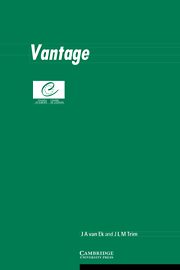Book contents
- Frontmatter
- Contents
- Introduction
- 1 The objective: levels of specificity
- 2 The objective: general characterisation
- 3 The objective: extended characterisation
- 4 The objective: components of the specification
- 5 Language functions
- 6 General notions
- 7 Topic-related tasks and lexicon
- 8 Discourse structure and verbal exchange
- 9 Dealing with texts: reading and listening
- 10 Writing
- 11 Sociocultural competence
- 12 Compensation strategies
- 13 Learning to learn
- 14 Degree of skill
- 15 By-products
- APPENDICES
9 - Dealing with texts: reading and listening
Published online by Cambridge University Press: 28 January 2010
- Frontmatter
- Contents
- Introduction
- 1 The objective: levels of specificity
- 2 The objective: general characterisation
- 3 The objective: extended characterisation
- 4 The objective: components of the specification
- 5 Language functions
- 6 General notions
- 7 Topic-related tasks and lexicon
- 8 Discourse structure and verbal exchange
- 9 Dealing with texts: reading and listening
- 10 Writing
- 11 Sociocultural competence
- 12 Compensation strategies
- 13 Learning to learn
- 14 Degree of skill
- 15 By-products
- APPENDICES
Summary
In relation to Threshold, Vantage is characterised by a relaxation of constraints. A major constraint at Threshold level is that the ability to deal with written and spoken texts that is expected of learners is related – and confined – to texts relevant to certain specified situations and to certain specified topics (see Threshold 1990, 3.3). At Vantage level the limitation to preselected situations and topics is abandoned (see also Chapter 7), and this means that, in principle, the understanding of texts relevant to any situation and to any topic may be required. Yet, Vantage is an objective for a particular target group – however large this group may be and however heterogeneous its composition – and it is still significantly lower than what is often referred to as ‘near-native level’. Consequently, in describing communicative ability at Vantage level we have to provide criteria for the delimitation of the range of texts that learners may be expected to be able to deal with.
These criteria are contained, explicitly or implicitly, in the following description of the relevant part of the objective:
The learner can understand the gist and relevant details, and identify the communicative intention, of written and of spoken texts which have the following characteristics:
1 they are directed at a readership/audience of average educational development;
2 they have a clear structure, both conceptually and formally;
3 the information contained in them is, on the whole, offered explicitly but may be implicit in transparent cases;
4 their understanding may require some familiarity with common features of the foreign culture;
[…]
- Type
- Chapter
- Information
- Vantage , pp. 88 - 92Publisher: Cambridge University PressPrint publication year: 2000



